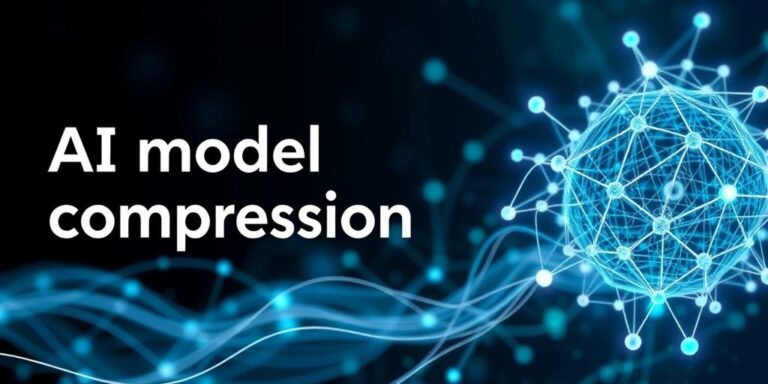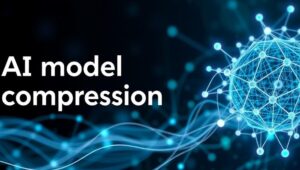AI Model Compression: Making Powerful AI Accessible (2025 Trends)
Artificial intelligence is rapidly transforming industries, but the size and complexity of AI models pose a significant challenge. Model compression techniques are emerging as a critical solution, enabling the deployment of powerful AI on resource-constrained devices. This article explores the key trends in AI model compression for 2025, highlighting how these advancements are democratizing access to AI.
The Challenge of Large AI Models
Modern AI models, particularly deep learning models, are massive. They require substantial computational resources for training and inference, making them difficult to deploy on edge devices like smartphones, IoT devices, and embedded systems. This limitation hinders the widespread adoption of AI in many applications.
What is AI Model Compression?
AI model compression refers to a set of techniques aimed at reducing the size and computational complexity of AI models without significantly sacrificing accuracy. By compressing models, it becomes feasible to run them on devices with limited resources, opening up new possibilities for AI-driven applications.
Key Model Compression Techniques
Several techniques are used to compress AI models. The primary methods include:
- Pruning: Removing unimportant connections or parameters from the model. This reduces the model’s size and computational requirements.
- Quantization: Reducing the precision of the model’s weights and activations. For example, converting 32-bit floating-point numbers to 8-bit integers can significantly decrease memory usage and accelerate computation.
- Knowledge Distillation: Training a smaller, more efficient model to mimic the behavior of a larger, more complex model. The smaller model learns to replicate the outputs of the larger model, effectively transferring knowledge from one to the other.
- Low-Rank Factorization: Decomposing weight matrices into smaller matrices, reducing the number of parameters in the model.
Trends in AI Model Compression for 2025
Several trends are shaping the future of AI model compression:
-
Automated Compression Techniques:
- Neural Architecture Search (NAS): NAS automates the design of efficient model architectures. By 2025, we expect to see more NAS-driven compression techniques that automatically identify the best compression strategy for a given model and task.
- Reinforcement Learning (RL): RL is being used to optimize the compression process. RL agents can learn to make intelligent decisions about which parts of the model to prune or quantize, maximizing compression while preserving accuracy.
-
Hardware-Aware Compression:
- Co-design: Model compression is increasingly being co-designed with hardware. This involves optimizing models to take full advantage of the capabilities of specific hardware platforms, such as specialized AI accelerators. As hardware becomes more tailored for AI, compression techniques will adapt to leverage these advancements.
-
Advanced Quantization Methods:
- Mixed-Precision Quantization: This technique involves using different levels of precision for different parts of the model. Some layers may be quantized to 8-bit, while others remain at 16-bit or 32-bit. This allows for a fine-grained trade-off between model size and accuracy.
- Quantization-Aware Training: Training models with quantization in mind from the start. This helps to mitigate the accuracy loss that can occur when quantizing a pre-trained model.
-
Integration with Edge Computing:
- On-Device Training: In 2025, we anticipate seeing more on-device training capabilities, where models are fine-tuned directly on edge devices after compression. This enables personalization and adaptation to local data without the need to transmit data to the cloud.
Impact and Applications
AI model compression is enabling a wide range of applications:
- Mobile Devices: Running complex AI tasks like image recognition, natural language processing, and augmented reality directly on smartphones and tablets.
- IoT Devices: Deploying AI on low-power IoT devices for applications such as smart sensors, predictive maintenance, and environmental monitoring.
- Autonomous Vehicles: Enabling real-time decision-making in self-driving cars through efficient on-board AI processing.
- Healthcare: Facilitating AI-driven diagnostics and personalized medicine on portable devices.
Challenges and Future Directions
Despite the progress, challenges remain:
- Maintaining Accuracy: Balancing compression with accuracy preservation is an ongoing challenge. Advanced techniques are needed to minimize the accuracy loss that can occur during compression.
- Standardization: A lack of standardization in compression techniques and tools can hinder adoption. Efforts are needed to develop common standards and benchmarks.
- Complexity: Implementing and optimizing compression techniques can be complex, requiring specialized expertise. More user-friendly tools and frameworks are needed to democratize access to these techniques.
Conclusion
AI model compression is a critical enabler for the widespread adoption of AI. As we move towards 2025, advancements in automated compression, hardware-aware techniques, and advanced quantization methods will make powerful AI accessible to a broader range of devices and applications. By addressing the challenges and continuing to innovate in this field, we can unlock the full potential of AI and transform industries across the globe.




